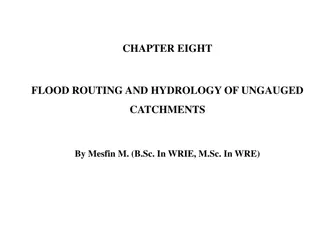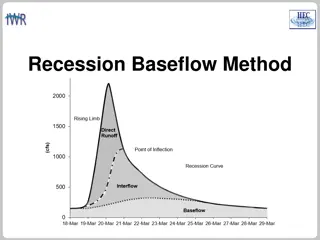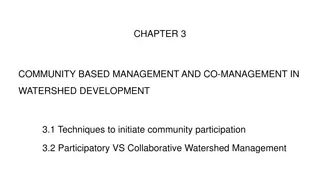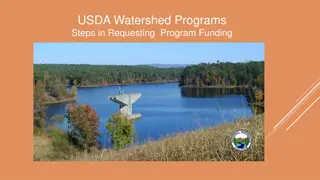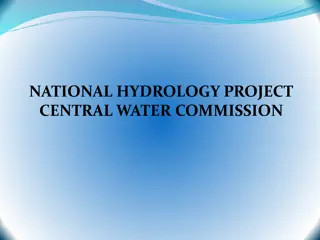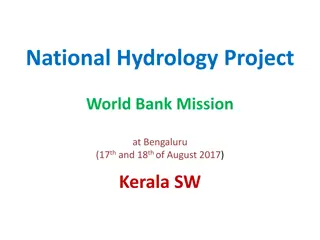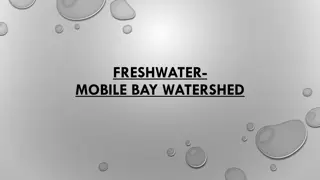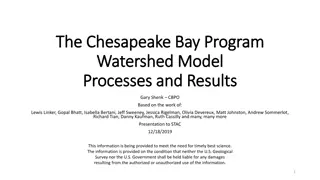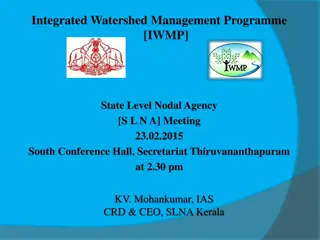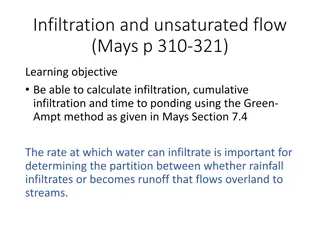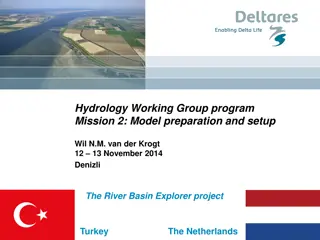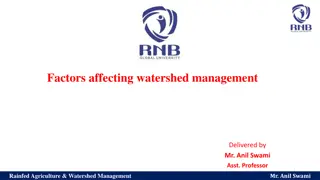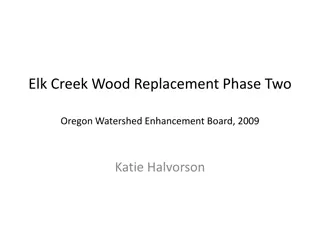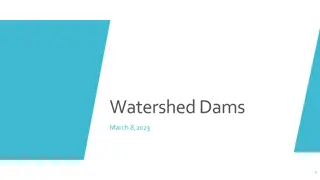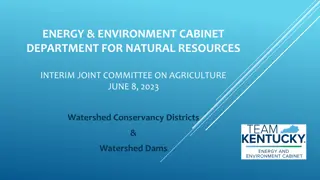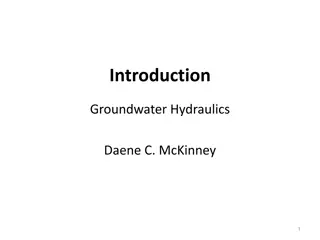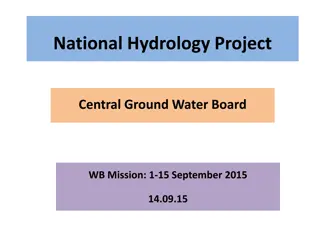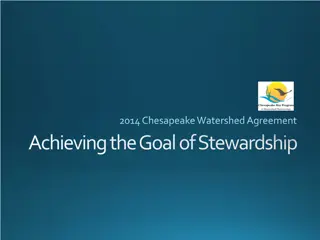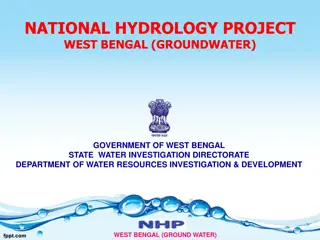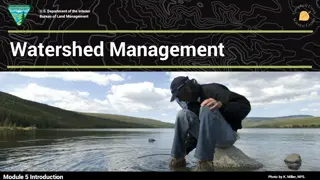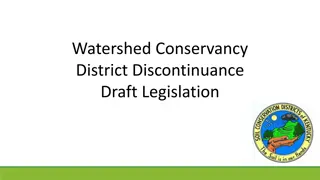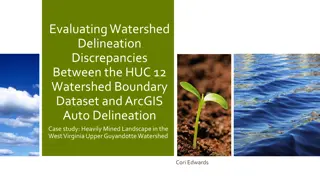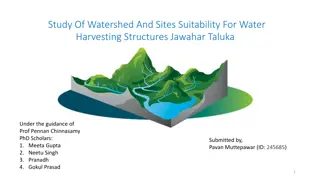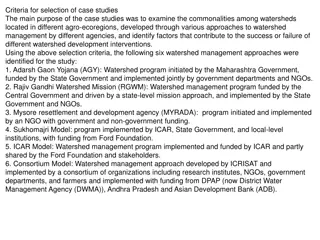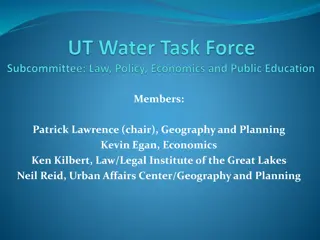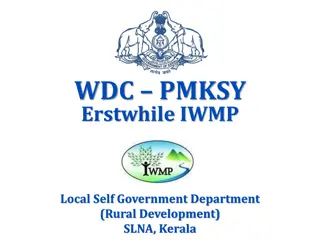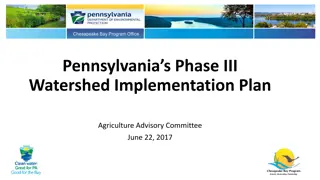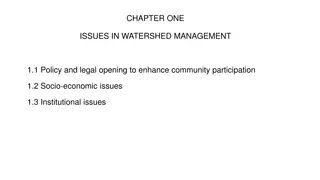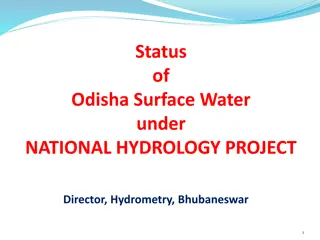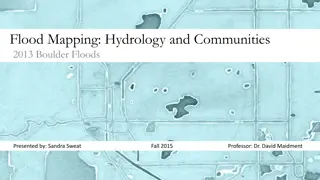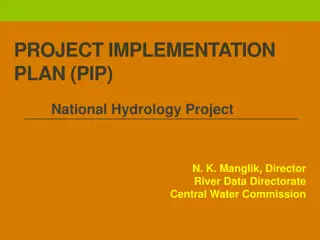Overview of Physical Hydrology and Hydroclimatology
Physical Hydrology and Hydroclimatology, a science focusing on water properties, distribution, and circulation, covers topics such as mass balance, watershed transfer functions, reservoir sizing, storage-yield analysis, and optimal yield calculations. The concept of optimal yield highlights the impo
4 views • 10 slides
Flood Routing and Hydrology of Ungauged Catchments
This publication by Mesfin M. explores the important aspects of flood routing and hydrology in ungauged catchments. The content covers various topics related to analyzing and managing floods, especially in areas without monitoring stations. With detailed insights and informative slides, this resourc
2 views • 41 slides
Understanding Precipitation and Rainfall Patterns in Hydrology
Exploring the various forms of precipitation like rainfall, snowfall, hail, and sleet, this lesson delves into the complexities of precipitation forms, intensity classifications, types of rain gauges, and methods for correcting deficiencies in rainfall data. Through detailed descriptions and images,
1 views • 39 slides
Understanding Runoff in Hydrology
Runoff in hydrology refers to surface water flow from precipitation and other sources in drainage basins. It plays a crucial role in stream flow and peak flood formation, influenced by factors like overland flow, interflow, and groundwater flow. This article explores the sources of runoff, including
3 views • 27 slides
Understanding the Recession Baseflow Method in Hydrology
Recession Baseflow Method is a technique used in hydrology to model hydrographs' recession curve. This method involves parameters like Initial Discharge, Recession Constant, and Threshold for baseflow. By analyzing different recession constants and threshold types such as Ratio to Peak, one can effe
0 views • 8 slides
Community-Based Management in Watershed Development
Techniques to initiate community participation in watershed management are crucial for sustainable development. Scholars classify participation levels into different categories, highlighting the importance of ideological motivation and voluntary engagement. The shift from direct intervention to part
0 views • 28 slides
Understanding USDA Watershed Programs for Local Communities
USDA Watershed Programs offer assistance in addressing natural resource issues such as flood control, repairing flood damages, and rehabilitating flood control dams. The three major components - Emergency Watershed Program (EWP), Watershed Protection and Flood Control Program (WPFO), and Watershed R
0 views • 15 slides
National Hydrology Project by Central Water Commission
The National Hydrology Project led by the Central Water Commission focuses on river basin planning, dividing the country into 20 rivers encompassing major and composite basins. The proposed basin studies detail catchment areas, with phases of consultancy involving model development and scenario anal
0 views • 20 slides
Engineering Hydrology Course Overview and Great Salt Lake Evaporation Analysis
Engineering Hydrology course led by David Tarboton covers principles of hydrology, water balance concepts, and hydrologic modeling. The analysis of Great Salt Lake evaporation explores factors such as inflow, area, and precipitation to determine the average annual evaporation rate.
1 views • 18 slides
National Hydrology Project Overview and Progress Report
The National Hydrology Project, supported by the World Bank, aims to enhance water resource management in Kerala through strategic supervision and policy guidance. The State Level Project Steering Committee provides direction and support, while the SPMU oversees project implementation and major proc
0 views • 22 slides
Exploring the Freshwater Mobile Bay Watershed
The Mobile Bay Watershed covers a vast area across multiple states, with various rivers and water bodies interconnected through a network of tributaries. Major Alabama rivers, including the Mobile River and the Tombigbee River, flow through this watershed, supporting diverse ecosystems. However, env
0 views • 8 slides
Chesapeake Bay Program Watershed Model Overview
The Chesapeake Bay Program's Watershed Model, presented to STAC in December 2019, provides insights on long-term average pollutant loads and land use dynamics in the Chesapeake Bay watershed. The model incorporates inputs such as land use acres, BMPs, and delivery mechanisms to estimate pollutant lo
0 views • 41 slides
Integrated Watershed Management Programme State Level Nodal Agency Meeting Report
The State Level Nodal Agency meeting for the Integrated Watershed Management Programme was held on 23rd February 2015 in Thiruvananthapuram, where various agenda items were discussed, including confirmation of previous meeting minutes, action taken reports, project approvals, and resolving project d
0 views • 54 slides
Understanding Watershed Processes and Habitat Impact
Explore the intricate relationship between stream processes, watershed factors, and habitat effects on local wildlife. Learn how climate, geology, soil, vegetation, water, and land use play crucial roles in shaping ecosystems. Discover the importance of maintaining a healthy vegetative community for
0 views • 27 slides
Understanding Infiltration and Unsaturated Flow in Hydrology
This content delves into the key concepts of infiltration and unsaturated flow in hydrology, focusing on calculating infiltration, cumulative infiltration, and time to ponding using the Green-Ampt method. It covers important topics such as runoff rate, infiltration capacity, cumulative infiltration,
0 views • 8 slides
Hydrology Working Group Program Mission 2: Model Preparation and Setup
This content describes the activities of the Hydrology Working Group program Mission 2, focusing on model preparation and setup for the River Basin Explorer project in Turkey and the Netherlands. It covers topics such as water balancing, water supply and demand, infrastructure, and the R.I.B.A.S.I.M
0 views • 15 slides
Factors Influencing Watershed Management Explained by Mr. Anil Swami
Mr. Anil Swami, an Assistant Professor specializing in Rainfed Agriculture & Watershed Management, discusses the factors affecting watershed management. These factors are categorized into watershed characteristics, climatic characteristics, land use patterns, social status, and organization. Watersh
0 views • 18 slides
Elk Creek Wood Replacement Project Overview
This project, led by the Oregon Watershed Enhancement Board in 2009 and documented by Katie Halvorson, focuses on the replacement of wood structures in Elk Creek to enhance watershed function and habitat complexity for juvenile coho salmon. By addressing the lack of large wood, the initiative aims t
0 views • 20 slides
Watershed Dams Rehabilitation Program in Kentucky
The Watershed Dams Rehabilitation Program in Kentucky aims to address the critical need for rehabilitating high hazard dams to ensure public safety and prevent economic damage. With funds allocated for grant programs and local sponsor matches, the initiative targets key priority dams identified by t
0 views • 8 slides
Watershed Conservation and Dam Rehabilitation Initiatives Overview
Explore the functions and responsibilities of Watershed Conservancy Districts in maintaining watershed dams, the funding mechanisms for dam rehabilitation projects, and the prioritized dam rehabilitation initiatives in Kentucky. Learn about the Watershed Dam Fund and its role in supporting the rehab
0 views • 8 slides
Understanding Groundwater Hydraulics and Hydrology
Explore the fundamentals of groundwater hydraulics and hydrology in this course, covering topics such as Darcy's law, aquifer testing, unsaturated flow, and more. Dive into practical applications and participate in a team project focusing on limiting hydraulic containment of contaminated aquifers. G
0 views • 25 slides
Understanding Groundwater Hydrology Concepts at Brigham Young University
Explore the derivation of transient terms, specific storage mechanisms, and distinctions between specific storage, storativity, and specific yield in groundwater hydrology. Delve into the mathematical equations governing groundwater flow and storage, understanding the change in mass stored in the sy
0 views • 17 slides
National Hydrology Project Overview and Achievements
The National Hydrology Project focuses on strengthening ground water monitoring networks, standardizing data collection methodologies, and infrastructure development. It aims to enhance institutional capabilities and software development for data processing and dissemination. The project has achieve
0 views • 18 slides
Achieving the Goal of Stewardship in the Chesapeake Watershed Agreement
The Chesapeake Watershed Agreement aims to increase the number and diversity of local citizen stewards and local governments supporting conservation and restoration activities for healthy local streams, rivers, and the Chesapeake Bay. Recognizing the importance of local involvement, citizen stewards
0 views • 8 slides
National Hydrology Project in West Bengal - Groundwater Management Overview
This document details the National Hydrology Project in West Bengal, focusing on groundwater management initiatives by the Government of West Bengal. It includes information about the project structure, management units, fund received and expenditure, as well as the cost components. Key personnel an
0 views • 27 slides
Understanding Watershed Management: Balancing Needs and Resources
Exploring the importance of watersheds in providing natural resources, the consequences of human modifications, and how communities strive to balance human needs with protecting watershed health. This module delves into the sources of community essentials like water, electricity, and heat, emphasizi
1 views • 12 slides
New Procedure for Watershed Conservancy District Discontinuance
A draft legislation proposes a new procedure for discontinuing inactive Watershed Conservancy District boards. Key points include criteria for initiating discontinuance, public notification requirements, voting procedures, and provisions for district boundaries and responsibilities. The legislation
0 views • 6 slides
Evaluating Watershed Delineation Discrepancies in West Virginia
This case study explores differences between NRCS Watershed Boundary Dataset and ArcGIS auto delineation in the Upper Guyandotte Watershed in West Virginia. The project aims to quantify discrepancies, analyze landscape characteristics, examine mining impacts, and assess the variations' effects on hy
0 views • 18 slides
Sustainable Watershed Planning in Stevens County, Washington
The Colville River watershed, known as WRIA 59, is the focus of sustainable watershed planning in Stevens County, Washington. The planning aims to address current and future water needs while protecting and enhancing the water resources within the area. Regulations around water rights, land use, and
1 views • 19 slides
Study of Watershed and Sites Suitability for Water Harvesting in Jawhar Taluka
This project aims to address water scarcity in Jawhar Taluka by studying watershed characteristics and identifying suitable sites for water harvesting structures. The methodology includes DEM analysis using QGIS Grass, watershed delineation, stream extraction, and site suitability assessment based o
0 views • 4 slides
Analysis of Different Watershed Management Approaches in Various Agro-Ecoregions
This study examines six different watershed management approaches implemented in diverse agro-ecoregions, focusing on the commonalities, success, and failures of interventions. The case study of Adarsh Gaon Yojana (AGY) in Maharashtra highlights the principles and approach towards sustainable villag
0 views • 13 slides
Watershed Management Research Projects in Maumee Watershed
Explore five key research tasks focusing on policies, practices, and impacts concerning nutrient loading into Lake Erie from the Maumee Watershed. Projects include examining CAFOs and CAFFs, declaring the Maumee a distressed watershed, regulating nutrients on farmland, addressing residential lawn fe
0 views • 6 slides
Progress Review Meeting for PMKSY Watershed Projects - Financial Updates and Project Status Assessment
The review meeting held on 10/06/2016 at the Government Guest House in EKM discussed the financial progress and project status of PMKSY Watershed Projects in various districts including Kasargode, Kannur, Kozhikode, Malappuram, Palakkadu, and Wayanadu. The detailed analysis included the project cost
0 views • 64 slides
Watershed Development Programme in Kerala: A Comprehensive Overview
The Watershed Development Programme in Kerala underwent significant transformations over the years, evolving from the Integrated Watershed Management Programme to its current form under the Pradhan Mantri Krishi Sinchayee Yojana. The program's implementation involves various institutional mechanisms
0 views • 43 slides
Pennsylvania's Phase III Watershed Implementation Plan
Pennsylvania's Phase III Watershed Implementation Plan focuses on reducing nitrogen, phosphorus, and sediment loading to meet Chesapeake Bay Total Maximum Daily Load requirements by 2025. The plan involves various sectors like agriculture, urban runoff, and forest areas to achieve necessary reductio
0 views • 30 slides
Issues in Watershed Management: Policy, Legal, and Community Participation
Policy and legal frameworks play a crucial role in enhancing community participation in watershed management. Understanding policy impacts, participatory processes, and implementation strategies are key for effective management planning. Definitions of policy, its components, and what it is not are
0 views • 81 slides
Overview of Odisha Surface Water under National Hydrology Project
Odisha's surface water status under the National Hydrology Project involves the State Project Monitoring Unit (SPMU) and Project Monitoring Unit (PMU) overseeing the implementation. Funds received, major procurement items, and year-wise expenditure details are outlined, highlighting the activities a
0 views • 13 slides
Hydrology and Communities: Understanding Flood Events in Boulder 2013
Explore the intersection of hydrology and community data in the context of the 2013 Boulder floods. Discover the various data sources, visualizations, and strategies used to map and assess flood risk in the St. Vrain Watershed. Learn about FEMA's NFHL mapping and the importance of tracking events to
0 views • 17 slides
Understanding Hydrology: The Science and Importance of Water
Hydrology is the science that studies the occurrence, circulation, and distribution of water on Earth, including its chemical properties and interaction with the environment. It involves estimating water resources, controlling floods and droughts, managing water use, and studying physical processes
0 views • 25 slides
National Hydrology Project Implementation Plan by N.K. Manglik
The National Hydrology Project, led by N.K. Manglik, aims to enhance hydrological forecasting and management in India. The Project Implementation Plan includes activities like flash flood guidance, basin-wise prediction models, and strengthening water technology centers. With a focus on flood manage
0 views • 36 slides

